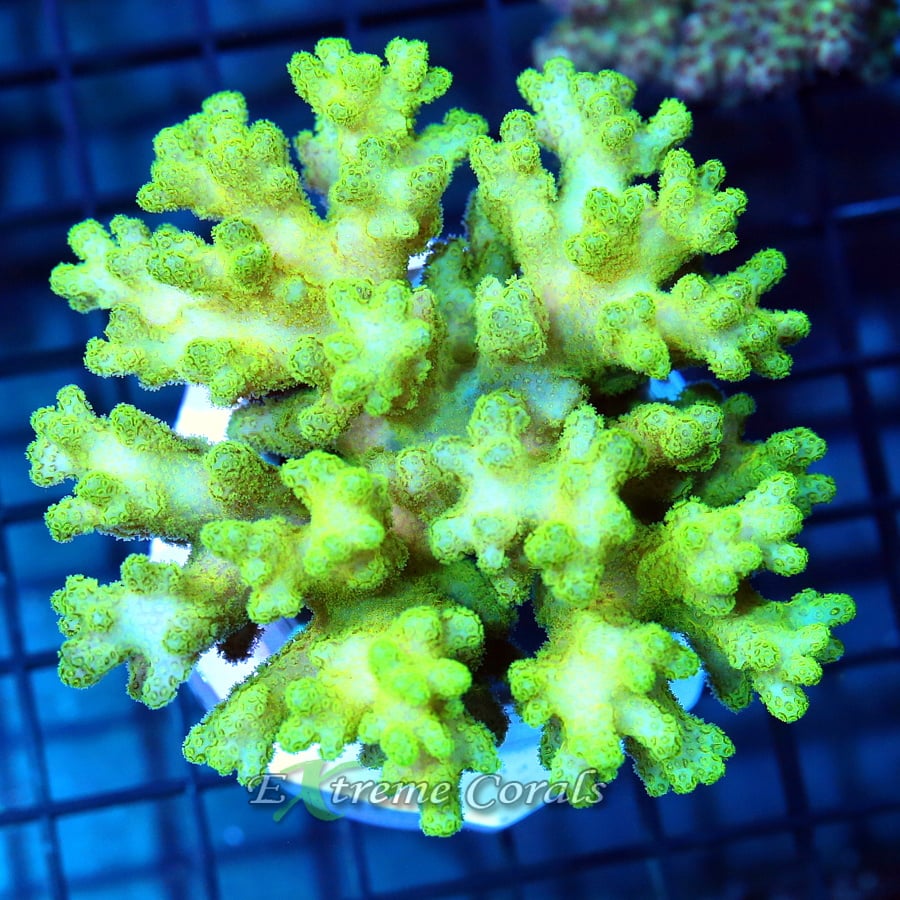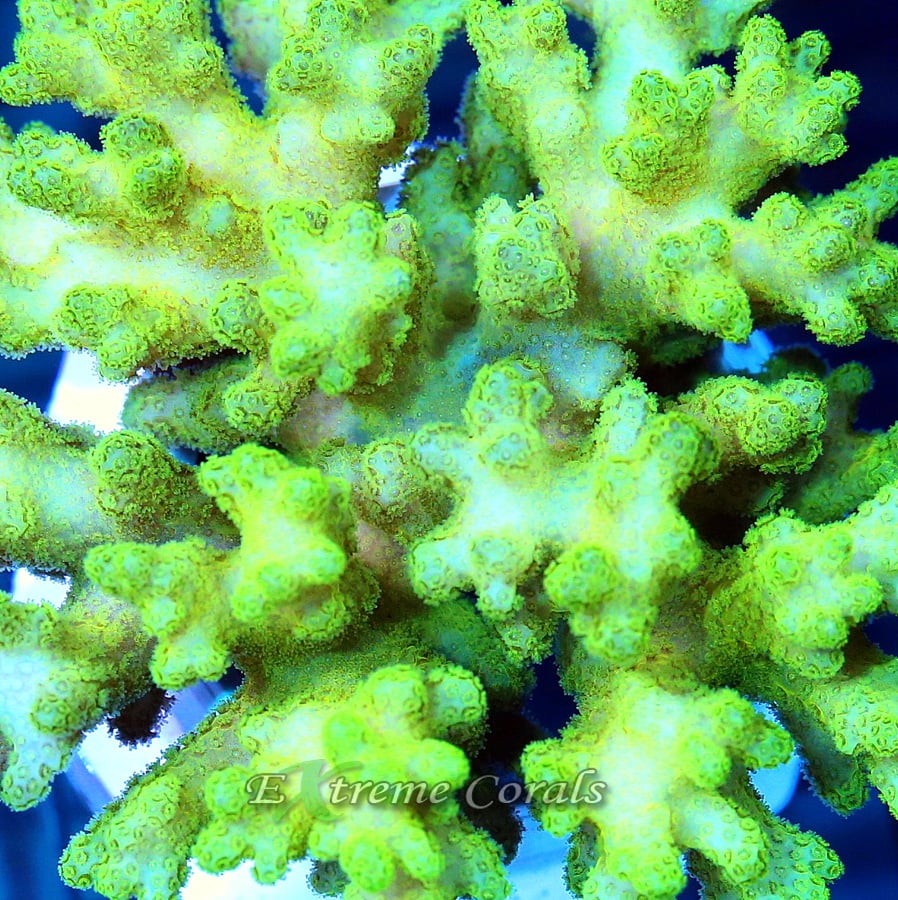Extreme Corals News and Updates
The Beginner's Guide to Keeping Pocillopora Corals in Your Reef Aquarium
Mastering Pocillopora Coral Care in Your Reef Aquarium
Discover how to successfully keep pocillopora corals in your reef aquarium in our comprehensive guide on 'The Beginner's Guide to Keeping Pocillopora Corals in Your Reef Aquarium'.
by scott Shiles • March 28, 2024
Pocillopora Corals

Pocillopora corals are a popular SPS Coral for reef aquarium enthusiasts due to their vibrant colors and intricate branching structures. These corals are known for their hardiness and adaptability, making them a great option for beginners looking to add diversity to their tank. Pocillopora corals come in a variety of shapes and sizes, ranging from small, compact colonies to larger, bushy formations. With proper care and maintenance, these corals can thrive in a home aquarium, providing an attractive and dynamic display for your underwater world. These corals are also known for their fast growth rate under optimal conditions, which can lead to the creation of a beautiful reef scape in a relatively short amount of time.
Setting Up Your Reef Aquarium for Pocillopora Corals
Lighting: Pocillopora corals require moderate to high lighting levels. Ensure they receive the right amount of light to promote photosynthesis.
Water Flow: Maintain strong and consistent water flow in your aquarium to help Pocillopora corals thrive. Adequate flow also prevents detritus buildup.
Water Parameters: Monitor and maintain stable water parameters, including temperature, pH, and salinity. Fluctuations can stress corals.
Supplements: Consider supplementing with calcium, alkalinity, and magnesium to support coral growth and skeletal structure.
Feeding: While Pocillopora corals primarily obtain nutrients through photosynthesis, you can target-feed them occasionally with phytoplankton or zooplankton.
Placement: Find a suitable location in your aquarium with proper lighting and water flow. Ensure they have enough space to expand and grow without crowding other corals.
Monitoring: Regularly observe and monitor your Pocillopora corals for any signs of stress, bleaching, or disease. Take necessary actions promptly to maintain their health.
By following these guidelines, you can create a suitable environment for your Pocillopora corals to thrive and grow beautifully in your reef aquarium.
Light and Water Requirements
Light Requirements
Pocillopora corals need stronglighting to thrive in your reef tank. They prefer high-intensity LED lights or metal halides to stimulate their growth. Place them higher up in the tank, as they can tolerate brighter light. For water conditions, maintain stable temperature between 74-78°F and salinity levels at 1.025. Regular water testing and quality salt mix are crucial for their health.
Temperature and Water Flow Recommendations
For Pocillopora corals, maintaining a water temperature between 74°F and 78°F is essential. Providing moderate to strong water flow in your reef aquarium mimics the natural environment of these corals, promoting their growth and health. Aim for turbulent water movement to keep the corals happy and thriving.
Feeding and Supplementing for Healthy Pocillopora Corals
To keep your Pocillopora corals healthy, it's important to provide them with proper feeding and supplements. Here are some key points to consider:
Pocillopora corals are mainly photosynthetic, which means they rely on light for energy. Ensure they receive enough light to thrive.
Supplement their diet with phytoplankton and zooplankton to enhance their health and growth.
It's crucial to maintain stable water parameters, including proper levels of calcium, alkalinity, and magnesium to support their skeletal structure.
Regular water changes and the use of high-quality reef supplements can help provide essential nutrients for your corals.
Observing your corals regularly and adjusting their feeding and supplements as needed will help maintain their well-being in your reef aquarium.
Monitoring and Maintaining Water Parameters
To make sure your Pocillopora corals thrive in your reef aquarium, you need to keep a close eye on your water parameters. Here's a rundown of the key parameters you should monitor and maintain:
Temperature: Keep it stable between 75-78°F.
Salinity: Maintain it at 1.023-1.025 specific gravity.
pH: Aim for a stable pH level between 8.1-8.4.
Alkalinity: Keep it between 7-11 dKH.
Calcium: Maintain levels around 380-450 ppm.
Magnesium: Keep it between 1200-1350 ppm.
Consistently monitoring and maintaining these water parameters will help ensure the health and vitality of your Pocillopora corals.
Common Pocillopora Coral Health Issues
Pocillopora corals are generally hardy but can face health struggles. Keep an eye out for signs of trouble to maintain a healthy reef tank. Watch for these common health issues:
Bleaching: Stressors like high temperatures can cause corals to expel their zooxanthellae, leading to bleaching.
Brown Jelly Disease: This bacterial infection appears as a slimy, brown film on the coral, potentially causing tissue loss.
RTN (Rapid Tissue Necrosis): If you notice rapid tissue loss on your Pocillopora coral, it may be suffering from RTN, a severe condition.
STN (Slow Tissue Necrosis): Another tissue loss issue, STN, progresses more slowly but still demands prompt attention.
By being observant and addressing these issues promptly, you can help your Pocillopora corals thrive in your aquarium.
Fragging Pocillopora Corals
When it comes to fragging Pocillopora corals, it's essential to do it carefully to ensure the health of the parent colony and the newly created frags. Here are some key points to keep in mind:
Fragging Pocillopora corals involves carefully cutting a piece of the coral colony to create a new frag that can grow independently.
Make sure to use clean and sterilized tools to prevent introducing any infections to the corals.
After fragging, provide proper water parameters, including stable temperature, salinity, and lighting, to help the frags establish and grow successfully.
It's crucial to monitor the frags closely for signs of stress or any changes in their appearance, as they may need special care during the initial stages of growth.
Coral Placement and Compatibility
Coral placement in your reef tank is crucial for the health of your Pocillopora corals. Make sure to provide enough space between corals to prevent them from stinging each other. Some corals may not get along with Pocillopora, such as LPS corals like acans and chalices. Placing soft corals like zoanthids near Pocillopora can also cause issues. Research compatibility before adding new corals to ensure a harmonious environment for your reef inhabitants.
Tips for Successfully Keeping Pocillopora Corals
Pocillopora corals thrive in strong and consistent lighting. Make sure to place them in high-flow areas of your aquarium. Maintain stable water parameters, including temperature, pH, and salinity. Consider supplementing their diet with phytoplankton and zooplankton to promote growth. Regularly monitor the coral for signs of distress such as paling or tissue recession

